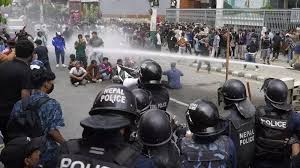The government of Nepal on Tuesday lifted its social media ban, a day after at least 19 people were killed during violent protests by young people demanding an end to the restrictions and action against corruption.
According to reports from AFP, all major platforms including Facebook, YouTube and X were restored in Kathmandu after days of blackout that had triggered nationwide demonstrations. Minister for Communication, Prithvi Subba Gurung, confirmed the decision and explained that reopening the platforms was one of the key demands of the protesters.
“The social media platforms have been opened, which was among the Gen Z’s demands,” Gurung said. “We are open to talk with the protesters.”
The Himalayan nation of about 30 million people had blocked access to 26 unregistered platforms on Friday, sparking widespread outrage. Young people, who rely heavily on social media for communication, networking, and activism, took to the streets across major cities. The protests quickly escalated into violent clashes with security forces.
On Monday, police launched one of the deadliest crackdowns in recent years, firing tear gas and reportedly using live ammunition. Amnesty International said evidence suggested that live bullets were fired at protesters, while the United Nations called for an urgent and transparent investigation into the deaths.
In the aftermath of the violence, a curfew was imposed in several cities on Tuesday morning, but many angry youths defied the restrictions. Eyewitnesses and local media reported that protesters targeted government buildings and the properties of politicians. Others burnt tyres in the streets while chanting slogans demanding justice and accountability.
“Nearly 20 people were murdered by the state — that shows the scale of police brutality,” said 23-year-old student, Yujan Rajbhandari, who took part in Monday’s protests. “The government has to take responsibility for the lives that were lost.”
Hospitals in Kathmandu struggled to cope with the surge of injured protesters. At least 400 people were reported injured, some with gunshot wounds. Ranjana Nepal, information officer at the Civil Hospital, described the scene as one of the most disturbing in recent memory.
“Tear gas entered the hospital area as well, making it difficult for doctors to work,” she said. “Dozens of injured were being treated at once, and the situation was chaotic.”
An AFP photographer covering the demonstrations reported that riot police used shields and vehicles to protect themselves from stone-throwing demonstrators outside the Parliament building. Images of the clashes showed streets filled with smoke, shattered glass, and protesters confronting heavily armed security forces.
The protests were largely led by Nepal’s young generation, many in their 20s, who accuse the government of corruption, poor governance, and lack of opportunities. Social media has been a major tool for mobilising demonstrations, and the attempt to shut it down only fuelled further anger.
Analysts say the protests reflect deep frustration with the political system, which has struggled with instability since the end of the country’s monarchy in 2008. The frequent change of governments, allegations of corruption, and weak economic reforms have left many citizens, particularly the youth, disillusioned.
The decision to lift the ban may calm tensions temporarily, but activists insist that the government must also take responsibility for the deaths, provide justice to victims’ families, and address systemic corruption. The coming days will determine whether dialogue between authorities and youth groups can prevent further violence.
International human rights organisations are closely monitoring the situation, warning that the excessive use of force against peaceful protesters could worsen Nepal’s image globally and deepen mistrust between the people and the government.
For now, Nepal’s streets remain tense as families mourn the dead and injured, while protesters prepare for further demonstrations if their broader demands remain unmet.
